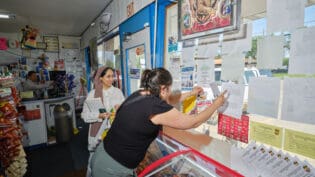
We’re Still Learning From Rosa Luxemburg
March 31, 2025
Taking Greenland Seriously
March 31, 2025On the morning of February 27, USAID workers who had been fired or placed on administrative leave during the Trump administration’s sudden dismantling of the agency went back to their offices at the Reagan Building and International Trade Center in Washington, D.C., for the last time.
They’d been assigned 15-minute windows to clean out their desks; the agency had shut down so quickly that many of them still had personal items in the office when Elon Musk’s so-called Department of Government Efficiency revoked their building access.
Outside the building, a crowd — made up at least in part by current or former federal workers, including former USAID administrator and UN ambassador Samantha Power — gathered to show their support for the USAID workers and protest against Trump and Musk.
Behind them, a black truck sat parked on Pennsylvania Avenue. LED billboards on both sides flashed a message to anyone walking by: “Are (were) you a government worker? ProPublica journalists want to hear from you.” A Signal number and url followed.
Photo by Jason Andrew, courtesy of ProPublica.
The truck’s journey to that spot had begun a few days earlier, as an email with the subject line “guerilla marketing for sources” in the inbox of Ariana Tobin, editor of ProPublica’s crowdsourcing and engagement team. It came from reporter Brett Murphy, who was covering the destruction of USAID with his reporting partner Anna Maria Barry-Jester. They’d been tipped off about the desk cleanouts; was there any chance, they asked Tobin, that they could send a billboard truck out on the morning of the 27th?
Tobin and her team were immediately on board. “It’s funny how you can know nothing about something like LED billboard trucks and then suddenly become an expert in them,” Maryam Jameel, an engagement reporter on Tobin’s team, told me. After a few calls, she found a company in Texas, which connected her to a subcontractor in New York, which in turn sent her to a driver with a billboard truck in Washington, D.C.
Soon, the truck became an operation that drew in people from across the newsroom, from interactive designers who usually work on the ProPublica website to copy editors who commented on how they’d never been asked to proofread a truck before.
The final design of the truck ad was simple, but getting there was an iterative process informed in large part by security concerns. The team batted around the idea of including a QR code on the truck to make sending in a tip as simple as scanning the code, but decided against it out of concerns that someone might manipulate the code in photos reposted online.
Similarly, while the company that ran the truck had a way to count impressions, the team decided not to use the feature because the data would be sent to a third party.
“We’re basically treating any conversation we’re having with someone who works for or used to work for the federal government as a maximum-security tip,” Tobin said. “That, frankly, is not what we used to do.”
The week of February 27, Murphy and Barry-Jester — who are both based in Brooklyn — couriered a stack of business cards to D.C., where Jameel planned to speak to people on the ground at the USAID offices. The tips inbox and Signal number on the truck are monitored by ProPublica’s engagement team, who can then route tipsters to the right reporters, but having Jameel hand out Murphy and Barry-Jester’s business cards to USAID workers helped establish a more personal connection from the jump.
“Truck day one was really interesting,” Jameel told me. “We didn’t know what to expect.”

Jameel talking to a federal employee outside the CFPB offices in March. Photo by Lexey Swall, courtesy of ProPublica.
She found a very receptive audience. “I think people viewed the truck as ProPublica caring about this and really wanting to reach them,” Jameel said. When she introduced herself to people on the ground, they often mentioned the truck; later, multiple sources told Murphy that they had seen the truck as well.
“For people who have never talked to journalists before, I think there’s a certain amount of mystery around what it means to be a tipster, or what it means to be a source,” Murphy told me. “So this was, more than anything, an invitation to just chat with us. If that means sharing a tip, that’s great. If that means [just] talking with us, that’s great, too…It’s not just a drive-by where we extract information from you and then we’re done with you. We want these to be long-term relationships.”
The truck isn’t the first time ProPublica has tried innovative methods of reaching new sources. When Jameel and her colleague Melissa Sanchez reported a series about working conditions on dairy farms, they reached undocumented workers by developing relationships with the hosts of local radio stations that they knew the workers listened to during their shifts and hung flyers at local businesses that served immigrant communities. For a story on crumbling schools in Idaho, reporters handed out instant cameras to students so they could document the damage themselves.
All of that outreach is part of a newsroom-wide focus on building deep, long-term relationships with sources. “Every single person has been very focused on this idea that right now, the thing that we need to do is build relationships with people who work and know about what’s happening at federal agencies,” Tobin said.
The emphasis, she said, is less on immediately turning tips into stories and more on showing people that ProPublica’s team is dedicated to big-picture accountability. “We occasionally hear from tipsters who ask ‘Why didn’t you cover my thing?’ We try to remind them that we’re thinking of it more as a feedback loop and relationship-building conversation,” Tobin said.
Building relationships beyond a single story is especially important when a source has lost their job. “What we would call ‘formers’ of a company or agency only know things first-hand up until the last day that they were there,” Murphy told me. “However, these people have a wealth of institutional knowledge, and they are subject matter experts in what these programs were doing before they halted operations. They know the broader context. They know what had been true in the past and what projections might be going forward. So just because they’re no longer there doesn’t mean they have any less value as sources. Regardless [of whether] they’re still at their desk or if they left weeks ago, they’re really important to me.”
The truck was such a success that it was deployed again to the Consumer Financial Protection Bureau when DOGE announced its plans to shut it down, and Tobin said it will continue to hit the streets when there are good opportunities. (According to Jameel, the first thing the truck driver said when he picked up the phone ahead of the deployment to the CFPB offices was, “Please tell me you’re calling because you want to do this again.”)
While tipsters will always be able to reach out via the general tip lines, the ProPublica homepage now also includes a directory of reporters grouped by interest area so potential sources can reach out directly to the reporters they think would be most interested in what they know.
“This started as a loose, kind of half-baked idea and turned into a real thing in a matter of days because of the extraordinary work done by my colleagues,” Murphy said. “Seeing half an idea turn into actual tips that then turned into a story was really great. It made me extremely proud to work at ProPublica.”
Tobin says ProPublica has heard from thousands of federal workers since January; there are so many tips coming in now that the team is hiring a dedicated tips coordinator to help triage everything and make sure potential sources get connected to the right people. And, Tobin says, the engagement team has an ever-growing bucket list of outreach methods they’d like to try one day.
“There are various things on wheels,” Tobin said. “I didn’t have LED billboard truck on my bingo card, though.”
One day, she said, she’d like to do trains.
Photo of the ProPublica truck outside of USAID’s former headquarters at the Ronald Reagan Building and International Trade Center in Washington, D.C, USA on February 25, 2025 by Jason Andrew, courtesy of ProPublica.
Great Job Neel Dhanesha & the Team @ Nieman Lab Source link for sharing this story.








